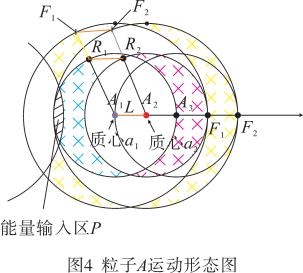First, time is a virtual space scale created by human beings with celestial movement as the frame of reference, and this space scale corresponds to the wavelength of energy transfer or particle (celestial body) movement, and the extended ratio is the concept of speed, the universe itself has no speed, because the universe itself has no concept of time, time and space are human definitions of the same thing in the universe from different angles, and the wavelength is 300,000 kilometers of space is defined as one second, that is, the speed of light, which can also be called the “one time” or “one” wavelength of energy [Note: a second is defined by humans, although humans do not use spatial distance as a reference when making the definition, but the result of human definition can be mapped on space (Figure 3)]. Therefore, “time” is a human concept, but energy has a transfer value, which I think is the progress value of the universe, and the progress value of the universe is synchronous positive and negative, that is, how many values of the universe progress (space radius), will have a corresponding negative value (the sum of the depth of the endpoints in the universe). However, if the universe has different progress values (expansion values) in different periods, the transfer value of energy will also change, that is, the speed of light may change in different cosmic periods (regardless of the transfer medium), I tend to think that the progress value of the universe may be increasing (the speed of light is accelerating). In this sense, the ratio of cosmic progress is the ratio of energy transfer,For example, if the universe expands by 300,000 kilometers, it is defined as one second of progress, so the age of the universe is usually defined by measuring the space radius of the universe.
Second, space is something we are both familiar with and unfamiliar, familiar because we live in space every moment of every day, we study, explore, and even create the concept of dimension (but this is the concept of human beings, the universe only exists breadth and depth, and the sum of breadth and depth is the inverse number of equivalent, in science fiction, human beings can go back to the “past” through the time tunnel or take the space-time train. And visit the “future”, this is the vision of human beings, in fact, we are in the past, present and future space every day, but the change of the spatial reference can not be transferred by our will, say a joke: want to return to the “past” or visit the “future” scene can only be realized in a dream. Space brings us infinite reverie, but we do not know its beginning and end, describing its existence is very difficult thing, I can only try to use
close language to express its progress, that is, “the place where energy has not yet arrived is the end of space, the place where energy begins is the beginning of space”, it is difficult for human beings to understand the concept of no (nothing), because human beings always associate “nothing” with “there”, we can not imagine a “nothing” world, in fact, “nothing” in the universe “Is independent existence, and” there “is positive and negative existence, that is, the end of” there “is” nothing “, the starting point of “nothing” is “there”, simply put, space is the wavelength relative to the endpoint of the universe.
Drawings and illustrations:

Illustration:
①The yellow part is the space scale defined by humans, that is, 1 second is defined as the space with a wavelength of 300,000 km.
②When particle A(A single frequency) moves from a1 to a2, the single frequency motion wavelength of particle A is L.
③The ratio of the space scale (the ratio of the yellow line to the green line) is the motion frequency of particle A in one second.
④The space scale of particle A is the diameter of particle A, and the motion frequency of particle A per second can be obtained by dividing the diameter of particle A by 300,000 km.
⑤The frequency multiplied by the wavelength is the velocity of particle A.
⑥If the speed of particle A is known, the motion wavelength of particle A can be calculated, and if the motion wavelength of particle A is known, the motion speed of particle A can be calculated.
⑦ The motion wavelength of particle A is the spatial scale corresponding value (L) of the ratio of the total wavelength energy of particle A to the total kinetic energy.
